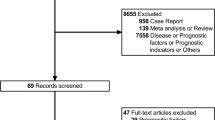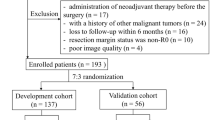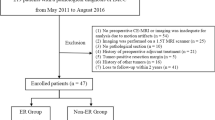Abstract
Objective
To investigate whether pre-treatment contrast-enhanced MRI could predict the therapeutic response of systemic treatment in advanced intrahepatic cholangiocarcinoma (ICC).
Methods
This retrospective study enrolled 61 ICC participants with contrast-enhanced MRI before combined systemic therapy. Clinical characteristics and MRI features were compared between patients with and without therapeutic response by univariate and multivariate logistic regression analyses. Then, a combined MRI-based model and the nomogram were established based on the results of the multivariate analysis. The diagnostic performances of significant findings and the combined model were evaluated and compared. The progression-free survival (PFS) rates between patients with high and low combined index values were compared.
Results
Thirty (49.18%) patients showed overall response after therapy. In multivariate analysis, tumor margin (odds ratio (OR) = 5.004, p = 0.014), T2 homogeneity (OR = 14.93, p = 0.019), and arterial peritumoral enhancement (OR = 5.076, p = 0.042) were independent predictive factors associated with therapeutic response. The C-index with the formulated nomogram incorporating the three independent imaging features was 0.828 (95% CI 0.710–0.913). Diagnostic characteristics of the combined index were superior to any single feature alone (p = 0.0007–0.0141). ICCs with high combined index values showed higher PFS rates than those with low values (χ2 = 13.306, p < 0.0001).
Conclusions
Pre-treatment contrast-enhanced MRI can be used to predict therapeutic response in advanced ICC with systemic therapy. The combination model incorporating significant MRI features achieved an improved predictive value, which may play an important role in identifying appropriate therapeutic candidates.
Key Points
• Contrast-enhanced MRI can predict response of systemic therapy in advanced ICC.
• MRI features of tumor margin, T2 homogeneity, and arterial peritumoral enhancement are related to therapeutic response.
• The combined MRI-based model may help to identify appropriate therapeutic candidates.





Similar content being viewed by others
Abbreviations
- ADC:
-
Apparent diffusion coefficient
- APE:
-
Arterial peritumoral enhancement
- AUC:
-
Area under the curve
- CI:
-
Confidence interval
- ICC:
-
Intrahepatic cholangiocarcinoma
- MRI:
-
Magnetic resonance imaging
- OR:
-
Odds ratio
- PD-1:
-
Programmed cell death protein 1
- PFS:
-
Progression-free survival
- RECIST:
-
Response Evaluation Criteria in Solid Tumors
- ROI:
-
Region of interest
References
Sirica AE, Gores GJ, Groopman JD et al (2019) Intrahepatic cholangiocarcinoma: continuing challenges and translational advances. Hepatology 69:1803–1815
Kelley RK, Bridgewater J, Gores GJ, Zhu AX (2020) Systemic therapies for intrahepatic cholangiocarcinoma. J Hepatol 72:353–363
Fiteni F, Nguyen T, Vernerey D et al (2014) Cisplatin/gemcitabine or oxaliplatin/gemcitabine in the treatment of advanced biliary tract cancer: a systematic review. Cancer Med 3:1502–1511
Jang JS, Lim HY, Hwang IG et al (2010) Gemcitabine and oxaliplatin in patients with unresectable biliary cancer including gall bladder cancer: a Korean Cancer Study Group phase II trial. Cancer Chemother Pharmacol 65:641–647
Llovet JM, Ricci S, Mazzaferro V et al (2008) Sorafenib in advanced hepatocellular carcinoma. N Engl J Med 359:378–390
Kudo M, Finn RS, Qin S et al (2018) Lenvatinib versus sorafenib in first-line treatment of patients with unresectable hepatocellular carcinoma: a randomised phase 3 non-inferiority trial. Lancet 391:1163–1173
Ueno M, Ikeda M, Sasaki T et al (2020) Phase 2 study of lenvatinib monotherapy as second-line treatment in unresectable biliary tract cancer: primary analysis results. BMC Cancer 20:1105
El-Khoueiry AB, Sangro B, Yau T et al (2017) Nivolumab in patients with advanced hepatocellular carcinoma (CheckMate 040): an open-label, non-comparative, phase 1/2 dose escalation and expansion trial. Lancet 389:2492–2502
Finn RS, Ryoo BY, Merle P et al (2020) Pembrolizumab as second-line therapy in patients with advanced hepatocellular carcinoma in KEYNOTE-240: a randomized, double-blind, phase III trial. J Clin Oncol 38:193–202
Ilyas FZ, Beane JD, Pawlik TM (2021) The state of immunotherapy in hepatobiliary cancers. Cells 10:2096
Lee YJ, Lee JM, Lee JS et al (2015) Hepatocellular carcinoma: diagnostic performance of multidetector CT and MR imaging-a systematic review and meta-analysis. Radiology 275:97–109
Kudo M (2020) Gd-EOB-DTPA-MRI could predict WNT/beta-catenin mutation and resistance to immune checkpoint inhibitor therapy in hepatocellular carcinoma. Liver Cancer 9:479–490
Yoon JH, Lee JM (2019) Can MRI features predict prognosis in mass-forming intrahepatic cholangiocarcinoma? Radiology 290:700–701
Pandey A, Pandey P, Ghasabeh MA et al (2018) Baseline volumetric multiparametric MRI: can it be used to predict survival in patients with unresectable intrahepatic cholangiocarcinoma undergoing transcatheter arterial chemoembolization? Radiology 289:843–853
Kim S, An C, Han K, Kim MJ (2019) Gadoxetic acid enhanced magnetic resonance imaging for prediction of the postoperative prognosis of intrahepatic mass-forming cholangiocarcinoma. Abdom Radiol (NY) 44:110–121
Eisenhauer EA, Therasse P, Bogaerts J et al (2009) New response evaluation criteria in solid tumours: revised RECIST guideline (version 1.1). Eur J Cancer 45:228–247
Bertuccio P, Malvezzi M, Carioli G et al (2019) Global trends in mortality from intrahepatic and extrahepatic cholangiocarcinoma. J Hepatol 71:104–114
Chen J, Wu Z, Xia C et al (2020) Noninvasive prediction of HCC with progenitor phenotype based on gadoxetic acid-enhanced MRI. Eur Radiol 30:1232–1242
Zhao YJ, Chen WX, Wu DS, Zhang WY, Zheng LR (2016) Differentiation of mass-forming intrahepatic cholangiocarcinoma from poorly differentiated hepatocellular carcinoma: based on the multivariate analysis of contrast-enhanced computed tomography findings. Abdom Radiol (NY) 41:978–989
Wei Y, Pei W, Qin Y, Su D, Liao H (2021) Preoperative MR imaging for predicting early recurrence of solitary hepatocellular carcinoma without microvascular invasion. Eur J Radiol 138:109663
Ahn KS, Kang KJ (2020) Molecular heterogeneity in intrahepatic cholangiocarcinoma. World J Hepatol 12:1148–1157
Braconi C, Roessler S, Kruk B, Lammert F, Krawczyk M, Andersen JB (2019) Molecular perturbations in cholangiocarcinoma: is it time for precision medicine? Liver Int 39(Suppl 1):32–42
Wang X, Wang W, Ma X et al (2020) Combined hepatocellular-cholangiocarcinoma: which preoperative clinical data and conventional MRI characteristics have value for the prediction of microvascular invasion and clinical significance? Eur Radiol 30:5337–5347
Chong HH, Yang L, Sheng RF et al (2021) Multi-scale and multi-parametric radiomics of gadoxetate disodium-enhanced MRI predicts microvascular invasion and outcome in patients with solitary hepatocellular carcinoma ≤ 5 cm. Eur Radiol 31:4824–4838
Zhao H, Hua Y, Dai T et al (2017) Development and validation of a novel predictive scoring model for microvascular invasion in patients with hepatocellular carcinoma. Eur J Radiol 88:32–40
Yang L, Gu D, Wei J et al (2019) A radiomics nomogram for preoperative prediction of microvascular invasion in hepatocellular carcinoma. Liver Cancer 8:373–386
Zhou C, Wang Y, Ma L, Qian X, Yang C, Zeng M (2021) Combined hepatocellular carcinoma-cholangiocarcinoma: MRI features correlated with tumor biomarkers and prognosis. Eur Radiol 32:78–88
King MJ, Hectors S, Lee KM et al (2020) Outcomes assessment in intrahepatic cholangiocarcinoma using qualitative and quantitative imaging features. Cancer Imaging 20:43
Acknowledgements
This study was funded by the Natural Science Foundation of Fujian Province (grant number 2021D032), Shanghai Rising Stars of Medical Talent Youth Development Program (grant number SHWRS(2020)_087), the Shanghai Municipal Key Clinical Specialty (grant number shslczdzk03202), and the Clinical Research Plan of SHDC (grant number SHDC2020CR1003A). The authors thank the statistician Minzhi Lv for her support in statistical analyses in this work.
Funding
This study has received funding by the Natural Science Foundation of Fujian Province (grant number 2021D032), Shanghai Rising Stars of Medical Talent Youth Development Program (grant number SHWRS(2020)_087), the Shanghai Municipal Key Clinical Specialty (grant number shslczdzk03202), and the Clinical Research Plan of SHDC (grant number SHDC2020CR1003A).
Author information
Authors and Affiliations
Corresponding authors
Ethics declarations
Guarantor
The scientific guarantor of this publication is Mengsu Zeng.
Conflict of interest
The authors of this manuscript declare no relationships with any companies whose products or services may be related to the subject matter of the article.
Statistics and biometry
One of the authors has significant statistical expertise (Shanshan Gao). And Minzhi Lv kindly provided statistical advice for this manuscript.
Informed consent
Written informed consent was waived by the Institutional Review Board.
Ethical approval
Institutional Review Board approval was obtained by Zhongshan Hospital, Fudan University (Approval Number: B2021-113R).
Methodology
• retrospective
• diagnostic or prognostic study
• performed at one institution
Additional information
Publisher’s note
Springer Nature remains neutral with regard to jurisdictional claims in published maps and institutional affiliations.
Mengsu Zeng and Dong Wu contribute the same as corresponding authors.
Rights and permissions
About this article
Cite this article
Sheng, R., Huang, X., Jin, K. et al. Contrast-enhanced MRI could predict response of systemic therapy in advanced intrahepatic cholangiocarcinoma. Eur Radiol 32, 5156–5165 (2022). https://doi.org/10.1007/s00330-022-08679-6
Received:
Revised:
Accepted:
Published:
Issue Date:
DOI: https://doi.org/10.1007/s00330-022-08679-6




